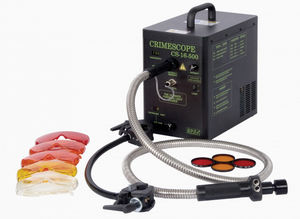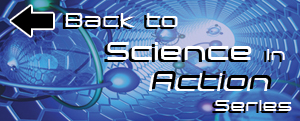
Alternative light sources used by crime scene investigators help them identify evidence left by suspects at a crime scene.
Rhode Island State Crime Laboratory Criminalist, Mark Zabinski has worked on thousands of cases for law enforcement. The crime lab serves the entire state, along with federal agencies that need assistance, including the Bureau of Alcohol, Tobacco and Firearms, and the Federal Bureau of Investigation.
Evidence gets submitted to the crime lab, which tries to identify a variety of materials, including fingerprints to develop latent prints. It then submits the results to law enforcement agencies.

Zabinski’s staff works at crime scenes and in the lab. They use the HORIBA Scientific SPEX CrimeScope CS-16-500 and the SceneScope Advanced RUVIS to detect evidence. The SceneScope is a Reflected Ultra-Violet Imaging System, and can visualize post latent prints on fairly smooth non-porous surfaces after being treated with a Superglue fuming process. In that process, the glue mist adheres to the moisture on the print and helps the scope see the image more clearly.
“There’s color in the background on a lot of items, like a soda can,” Zabinski said. “RUVIS doesn’t see color, so it’s not distracted.”
The CrimeScope essentially gets the same end result, visualizing prints on multicolored surfaces using a fluorescing process.
HORIBA Scientific’s SPEX division manufactures and distributes forensic light source evidence detection equipment and fingerprint analysis systems for law enforcement agencies at all levels of government, on the local, county, state, and federal levels, according to SPEX Division Manager, George Steola.
SPEX sells to all the federal agencies - anyone under the Department of Justice, as well as the military…anywhere there is a government agency which does investigative work.
“Our forensic light sources that go to the crime scene or stay in the lab are used to find evidence you can’t see with the naked eye,” Setola said. “Primarily, they treat fingerprint evidence with a compound that fluoresces. You can also see serology, body fluids left behind, trace evidence when you’re dealing with drugs, fibers, hairs that would be left behind that is not biological in nature. You can also do things like look for bone fragments, teeth, what’s left behind in a burial site. You can examine corpses with these devices. You can also look at the living victim for evidence of abuse, bruises, or skin damage on the surface and underneath the skin with these forensic light sources.”
SPEX users can go to a crime scene, collect different forms of evidence, bring it back to the lab to process further to detect more evidence. If you get fingerprints, you can output that information to SPEX’s fingerprint databases to try to identify an individual.
“In the fingerprint realm, we take it one step further where we can do identification,” Setola said. “You can take the fingerprints yourself that you find at the crime scene or at the lab and process it, and if you have our AFIS (Automated Fingerprint Identification System) system, you have a database built up so that we can run that fingerprint against the database and identify an individual.”
That would involve SPEX’s PrintQuest® system. A fingerprint collected from the crime scene is digitized, or lifted, and then inserted into the system. It scans the fingerprint and the system compares it to other fingerprints in the database. If there is a matching fingerprint in the database, it spits out the identity of the individual from the latent print collected at the crime scene.
SPEX detectors can also find bodily fluids that require further chemical analysis to determine their origin.
The SPEX detectors come in different sizes for various purposes and locations. Some travel easily to the crime scene, and some work better in the lab.
Back in Rhode Island, the SceneScope imager uses intensified UV reflectance instead of fluorescence, Zabinski said. The system can detect fingerprints on most non-porous surfaces prior to any treatment, or after a fuming. Fuming is required when preliminary examination yields no results.
SPEX instruments can also aid in the detection of domestic assault with its forensic light sources by detecting bruises and contusions. It can also aid the medical industry with people who are bedridden by detecting bed sores before they become visible and more serious.

У вас есть вопросы или пожелания? Используйте эту форму, чтобы связаться с нашими специалистами.